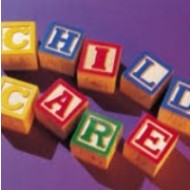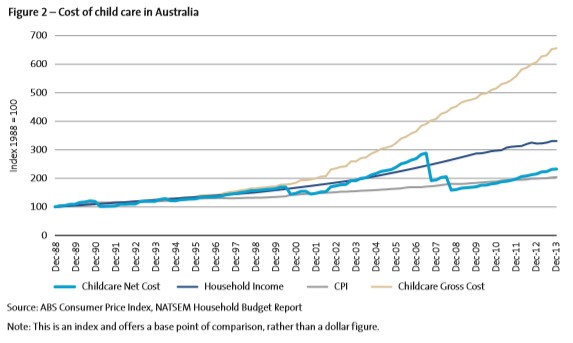
Social services minister, Kevin Andrews, was out and about over the weekend arguing that wider workforce participation rates will be needed amongst seniors and women in order to reduce the economic and budgetary pressures arising from an ageing population.
The reference to gaining higher workforce participation from women was clearly aimed at supporting the Abbott Government’s $5 billion paid parental leave (PPL) scheme, which is being marketed by the Coalition as a way of ensuring that mothers remain in the workforce, despite overwhelming evidence that its impact on workforce participation will be marginal, despite its great cost.
Coincidentally, the National Centre for Social and Economic Modelling (NATSEM), which is attached to the University of Canberra, released a new report over the weekend, which found that childcare costs are a growing burden for families and the Budget.
According to this report, the average cost of childcare has risen by 150% over the past decade, and has seen government subsidies for childcare rise to $5 billion a year, up from $900 million in 1999 (see next chart).

NATSEM’s report supports research released late last year by the Productivity Commission, which estimated that childcare costs families on average around 9% of their disposable income, with fees rising by 7% annually in the decade to 2011-12. This escalation in out-of-pocket expenses has also occurred despite strong growth in annual subsidies from the federal government, which have grown from $1.5 billion a year in the early 2000s to an estimated $5.2 billion last financial year, according to the Productivity Commission.
While discussing their latest report, Ben Phillips from NATSEM argued that greater subsidies for childcare would do more to get women back into the workforce than the proposed PPL scheme:
“Paid parental leave is a nice thing to have but it won’t impact whether you return to the workforce. It won’t make much difference to workforce productivity and it won’t do much for low-income families.
“It’s a $5.5 billion program where the more you earn the more you get, so it’s regressive and has no obvious benefit for workforce participation. Whereas childcare has a big impact in workforce participation, as well as positive outcomes for early learning among children”…
“There is good evidence that you get better education outcomes from investing in good quality childcare,” he said. “This, in turn, benefits the workforce and increases government tax revenue in the long term.
“If there is nothing further to offset rising childcare prices we are unlikely to see female workforce participation increase, at a time when we need to deal with the challenges of an ageing population.”
Certainly for many mothers, having children is detrimental to their careers – either because the cost of childcare makes working unattractive, or because they can only work part-time. To the extent that reforms to childcare arrangements can ease this burden, provide mothers with greater choice, and boost workforce participation, then they should be considered.
That said, Australian families also need to be realistic. Having children is a personal choice and no family should expect to have all of their childcare costs subsidised by other taxpayers. Existing arrangements are reasonably generous, albeit there is scope for improvement and improved flexibility.
Moreover, while some mothers wish to return to full-time work but choose not to because of the costs of childcare, many other families would prefer not to have both mum and dad working. However, because it is so difficult to raise a family on a single income these days, in no small part due to the inflated cost of housing in Australia, they are forced to return to work earlier than they would like, reluctantly sending their children to childcare. For this group, “childcare stress” is as much a symptom of an increased cost of living from housing, rather than the cost of childcare per se.
One thing’s for certain, however. Abandoning the Abbott Government’s flawed $5.5 billion PPL scheme, and channeling some of this funding into childcare, is a no brainer from both a policy and budgetary perspective, and would achieve far greater participation benefits at lower cost than PPL.

